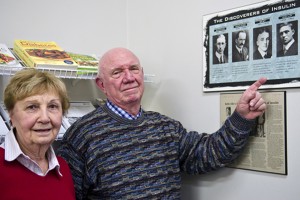Insulin discovery linked to Belleville
By Sharon Kallaste

BELLEVILLE, Ont. (23/01/12) Rosalie Spargo, Volunteer Team Leader of the Hastings and Prince Edward Diabetes Association Branch, and Dr. George Pearce of Belleville, are working together to attain recognition for Dr. James Betram Collip a native of Belleville. Collip worked with Dr. Frederick Banting, Charles Best and John MacLeod, the medical science team that discovered insulin. Pearce is creating an extensive archive of material on Collip which he intends to bequeath to the Belleville Archives. Photo by Sharon Kallaste
Life saving insulin has significant ties to Belleville.
Dr. George Pearce, of Belleville has made promoting the instrumental work of Dr. James Bertram Collip his personal life mission.
An advocate of the Hastings Historical Society, Pearce has volunteered his personal time and expense to create an archival exhibit with the hope and plans to memorialize Collip and donate his findings to the Belleville archives. Further, it is his hope that the City of Belleville might one day consider a historical monument.
Biochemist Dr. Collip, who was born in Thurlow Township who received his early education in Belleville was brought in by University of Toronto professor John Macleod late 1921 to work with Dr. Frederick Banting and Charles Best and formed the four-member team who discovered insulin.
Collips was given the task of purifying the insulin, so that it could be taken into the instrumental human testing stage.
Banting, had already initiated work involving the vital organ the pancreas that produces natural insulin, a blood sugar controlling hormone in late 1921.
Macleod, a prominent researcher of diabetes in Canada during that time, approved the use of University of Toronto resources that were needed, to include laboratory space, equipment, canine test subjects and a medical student Best to assist Banting with his work.
Once the team’s work reached the point of human testing, Leonard Thompson a 14 year-old boy was selected to be the first person with diabetes to be tested in January 1922. He received the purified insulin by injection, his health expediently improved from a near death pre-insulin state, resulting in the test being successful.
In 1923 only two of the four member medical team, Banting and MacLeod were nominated and awarded the Nobel Peace Prize for the ‘discovery of insulin’.
To this day there has been both debate and controversy, as to why Collip and Best were not recognized for their role in one of medicines greatest discoveries.
“There has been enough controversy about this and you don’t gain anything by polarizing the issue,” says Pearce.
“When I reached High School, a biology Teacher, who was a Senior, often spoke of his time at the University of Toronto, where he had met Frederick Banting,” said Pearce.
Pearce first became aware of diabetes at the age of 8, where an acquaintance introduced him to how he tested his urine by adding Fehling’s solution and heating the mixture, noting the colour change which would be used to determine the amount of insulin to be injected, usually in the thigh.
Pearce attended the University of Western Ontario during the time when Collip was Dean of Medicine and Director of Medical Research.
Medical School, Internships, community and Hospital practice kept Pearce in touch with those suffering from diabetes, as well as specialists who advised him on the care and medical management during his practice.
“I was feeling badly when I realized that there was no commemorative in Belleville for Dr. Bertram Collip,” said Pearce.
The instant one is told they have diabetes Banting and MacLeod become memorialized heros. There is no cure, for this debilitating and fatal disease. For those people with type 1, 10 per cent of all people living with diabetes without insulin will die.
“What I can probably do in my lifetime is organize what I have – several biographical sketches on Collip by librarians and nine bankers boxes filled with books and material that documents Collip’s life and work,” said Pearce.
Last July Pearce traveled to Alberta to visit various archives maintained by the province, city of Edmonton and the University of Alberta. Collip worked as a professor and head of the department of biochemistry for the university.
The University of Alberta, Hospital is where the first islet cell transplant procedure, known as the Edmonton Protocol was performed in 1999 by Dr. James Shapiro, Director of the Clinical Islet Cell Transplant Program.
Currently The Hastings County Historical Society does not hold a specific archival exhibit about Collip.
“I just work quietly away – the biggest thing I want to do is to contribute to the existing archives and have them brought to Collip’s birthplace,” said Pearce
“What I need to do is to find the appropriate channel, and the right place to present a motion, that will get the process [recognition] into action – it can take up to a hundred years to have a plaque or monument approved,” Pearce said with a smile.
“Dr. Pearce is a walking encyclopedia when it comes to the history of the insulin discovery,” says Rosalie Spargo, team leader of the Hastings and Prince Edward Diabetes Branch.
Spargo joined the branch in 2003. It is run by a complement of 18 volunteers that administer education, advocacy, resources and fundraising services to people living with diabetes in the community.
During her time with the Diabetes Association she has been a member of the Canadian Diabetes Advocacy Team that was instrumental in obtaining ministry funding to allow people living with diabetes type 1 the opportunity to receive an insulin pump.
“Dr. Pearce and I met at the Branch office several years ago. He came in to present his work, and to make available his findings to those living with diabetes that might be interested,” Spargo explained.
“He is so passionate about his work and the findings are really intriguing.
“Our branch is dedicated to assisting him with his efforts in anyway we can to increase awareness of diabetes, and bring community recognition to Dr. Collip’s role in the discovery of insulin,” said Spargo.
Pearce started creating his extensive archive on our hometown ‘hero’ Collip, in 2009.
“It would be appropriate to recall and retell his story in the community where he was born. It is a matter of pride to this community.
“It will serve to educate and inspire the students of today as to the importance of how Collip’s work played in saving millions of lives around the world,” said Pearce.
 Print This Post
Print This Post






